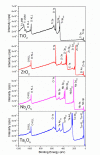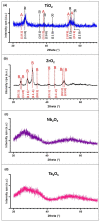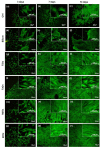Evaluation of the Biocompatibility and Osteogenic Properties of Metal Oxide Coatings Applied by Magnetron Sputtering as Potential Biofunctional Surface Modifications for Orthopedic Implants
- PMID: 35955174
- PMCID: PMC9369574
- DOI: 10.3390/ma15155240
Evaluation of the Biocompatibility and Osteogenic Properties of Metal Oxide Coatings Applied by Magnetron Sputtering as Potential Biofunctional Surface Modifications for Orthopedic Implants
Abstract
Biomaterials with adequate properties to direct a biological response are essential for orthopedic and dental implants. The surface properties are responsible for the biological response; thus, coatings with biologically relevant properties such as osteoinduction are exciting options to tailor the surface of different bulk materials. Metal oxide coatings such as TiO2, ZrO2, Nb2O5 and Ta2O5 have been suggested as promising for orthopedic and dental implants. However, a comparative study among them is still missing to select the most promising for bone-growth-related applications. In this work, using magnetron sputtering, TiO2, ZrO2, Ta2O5, and Nb2O5 thin films were deposited on Si (100) substrates. The coatings were characterized by Optical Profilometry, Scanning Electron Microscopy, Energy-Dispersive X-ray Spectroscopy, X-ray Photoelectron Spectroscopy, X-ray Diffraction, Water Contact Angle measurements, and Surface Free Energy calculations. The cell adhesion, viability, proliferation, and differentiation toward the osteoblastic phenotype of mesenchymal stem cells plated on the coatings were measured to define the biological response. Results confirmed that all coatings were biocompatible. However, a more significant number of cells and proliferative cells were observed on Nb2O5 and Ta2O5 compared to TiO2 and ZrO2. Nevertheless, Nb2O5 and Ta2O5 seemed to induce cell differentiation toward the osteoblastic phenotype in a longer cell culture time than TiO2 and ZrO2.
Keywords: magnetron sputtering; mesenchymal stem cells; metal oxide coatings; osteogenesis.
Conflict of interest statement
The authors declare no conflict of interest.
Figures










Similar articles
-
Hard Cr2O3 coatings on SS316L substrates prepared by reactive magnetron sputtering technique: a potential candidate for orthopedic implants.Environ Sci Pollut Res Int. 2021 May;28(20):25146-25154. doi: 10.1007/s11356-019-05006-3. Epub 2019 Apr 17. Environ Sci Pollut Res Int. 2021. PMID: 31001781
-
Application of magnetron sputtering for producing ceramic coatings on implant materials.Clin Oral Implants Res. 1993 Mar;4(1):28-34. doi: 10.1034/j.1600-0501.1993.040104.x. Clin Oral Implants Res. 1993. PMID: 8329535
-
Biological effects of sol-gel derived ZrO2 and SiO2/ZrO2 coatings on stainless steel surface--In vitro model using mesenchymal stem cells.J Biomater Appl. 2014 Nov;29(5):699-714. doi: 10.1177/0885328214545095. Epub 2014 Jul 29. J Biomater Appl. 2014. PMID: 25074359
-
Ion-substituted calcium phosphate coatings by physical vapor deposition magnetron sputtering for biomedical applications: A review.Acta Biomater. 2019 Apr 15;89:14-32. doi: 10.1016/j.actbio.2019.03.006. Epub 2019 Mar 6. Acta Biomater. 2019. PMID: 30851454 Review.
-
The modulation of stem cell behaviors by functionalized nanoceramic coatings on Ti-based implants.Bioact Mater. 2016 Sep 13;1(1):65-76. doi: 10.1016/j.bioactmat.2016.09.001. eCollection 2016 Sep. Bioact Mater. 2016. PMID: 29744396 Free PMC article. Review.
Cited by
-
Amorphous TiO2nano-coating on stainless steel to improve its biological response.Biomed Mater. 2024 Aug 21;19(5):055037. doi: 10.1088/1748-605X/ad6dc4. Biomed Mater. 2024. PMID: 39121890 Free PMC article.
-
Development of Wide-Angle Depolarizing Reflector at 1064 nm.Materials (Basel). 2023 Jun 8;16(12):4258. doi: 10.3390/ma16124258. Materials (Basel). 2023. PMID: 37374440 Free PMC article.
-
Biomaterials as Implants in the Orthopedic Field for Regenerative Medicine: Metal versus Synthetic Polymers.Polymers (Basel). 2023 Jun 7;15(12):2601. doi: 10.3390/polym15122601. Polymers (Basel). 2023. PMID: 37376247 Free PMC article. Review.
-
UV Sterilization Effects and Osteoblast Proliferation on Amorphous Carbon Films Classified Based on Optical Constants.Bioengineering (Basel). 2022 Sep 26;9(10):505. doi: 10.3390/bioengineering9100505. Bioengineering (Basel). 2022. PMID: 36290473 Free PMC article.
References
-
- Siti Nur Hazwani M.R., Lim L.X., Lockman Z., Zuhailawati H. Fabrication of Titanium-Based Alloys with Bioactive Surface Oxide Layer as Biomedical Implants: Opportunity and Challenges. Trans. Nonferrous Met. Soc. China Engl. Ed. 2022;32:1–44. doi: 10.1016/S1003-6326(21)65776-X. - DOI
Grants and funding
LinkOut - more resources
Full Text Sources

